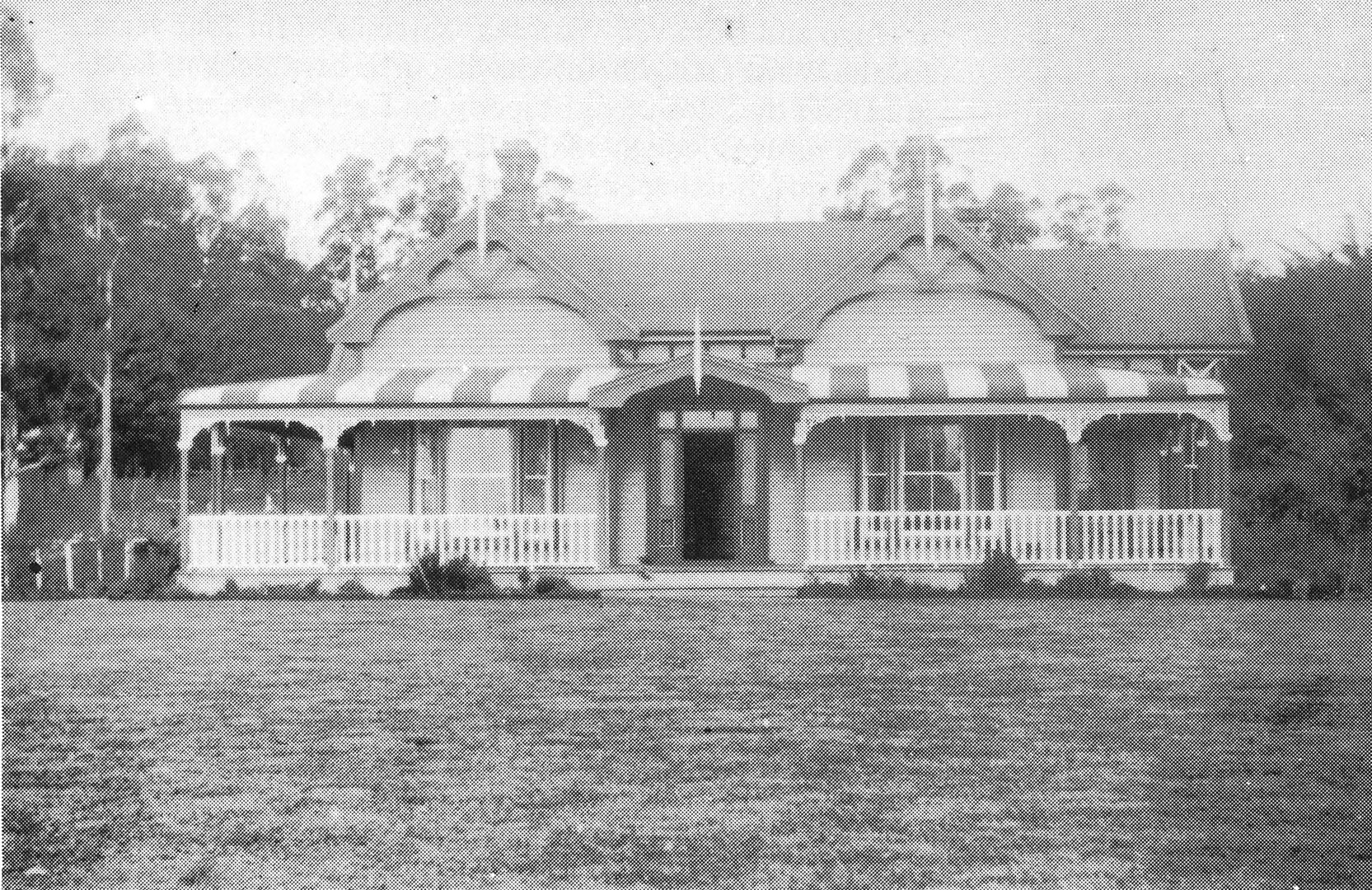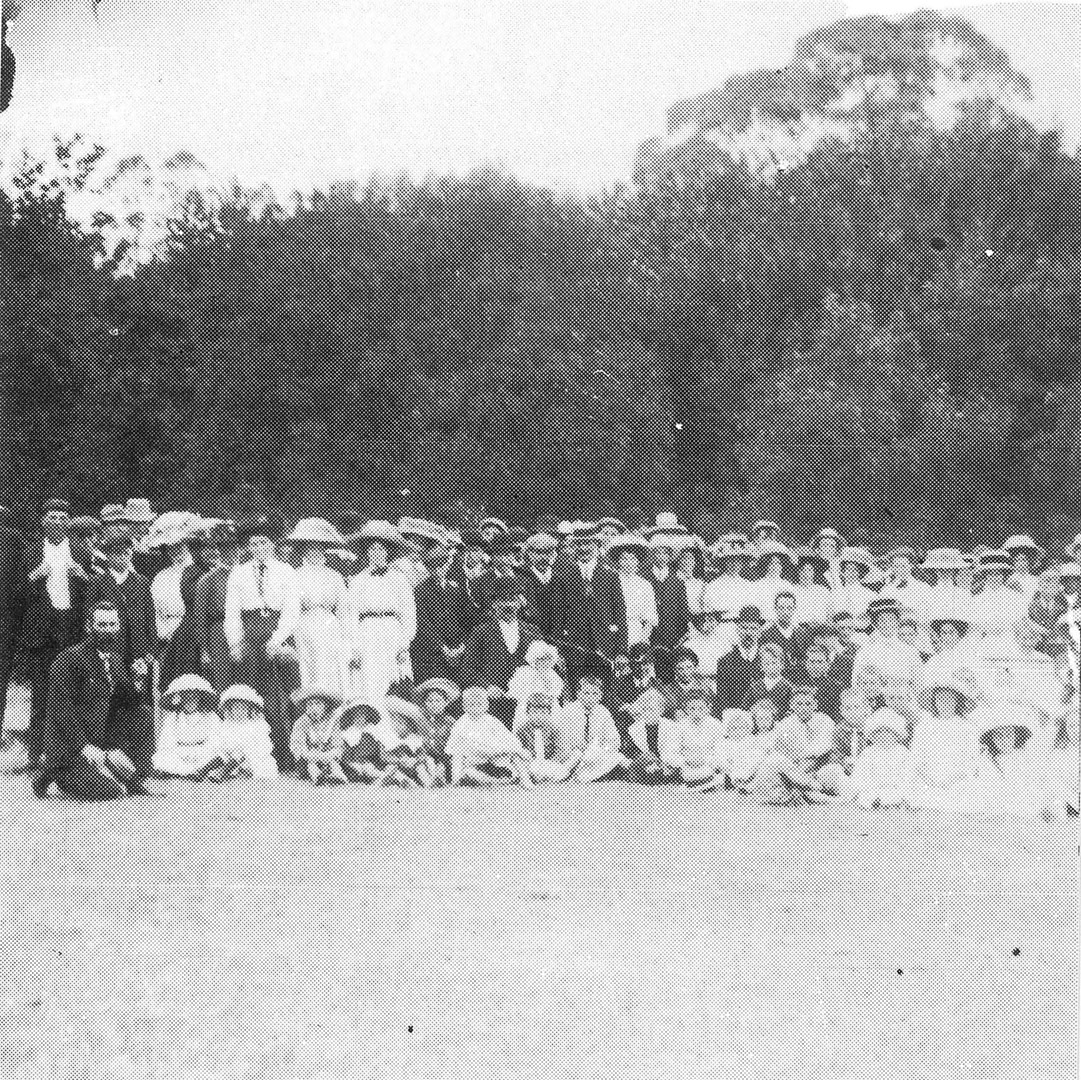
Perched atop the Hill, the Eureka homestead has always commanded a panoramic view of the surroundmg district. For more than three decades after its erection the homestead was the focal point for the flourishing little community.
During Henry Reynolds' tenure as manager it was the pivot of the company's operations. It was from here that Mr Reynolds pushed ahead with his seemingly impossible task.
Yet by the end of 1878 great strides had been made in the taming of the swamp. A reporter, roving the area, wrote a glowing article on the progress.1
'' .. . Having thus satisfied a morbid curiosity to walk over the celebrated swampland and see how it looked we are pleased with the change effected by the transforming hand of the company.
''Instead of a useless wilderness of flax, whose leaves reecho the dismal howling of the wind, it is a clover and grass-covered plain, the air resounding with the contented bleating of sheep mingled with the lowing of herds of cattle.
''Some distance from Eureka Hill a large gate blocked the entrance to the property. On either side of the gateway the land was well stocked with trees. The roadway was even for about four kilometres and had the appearance ofa carriage drive through a park. There were two main drains near the roadway and into these ran numerous feeder drains. Progressing down the road there was a continuous expanse of flax and rushes. But, nearing Eureka Hill the signs of extensive cultivation became obvious.
"The rape was three feet high; it was in full blossom presenting a very pleasing sight and looking like so many miles of buttercup-covered meadows from which sparrows and linnets start in flocks. Scotch thistles, sow thistles and dandelions also flourish exceedingly well ...''
The most advanced reclamation work was around the homestead block. Mr Reynolds' home and offices were built on the summit of the rising knoll and by 1878 the scene around the hill was similar to looking down on a prairie. On every side lay a vast area of drained swamp land. Luxuriant borders of clover and rye grass grew by the wayside of the road leading to the company's land.
Eight hectares around the homestead were used as an orchard, flower and kitchen garden. Ornamental shrubs and flowers bordered the carriage drive to the house. Visitors were greeted by a brilliant array of flowers and well-kept lawn just outside the front door. The orchard by this period contained 1000 trees. Once it had been so waterlogged that the horses ploughing the area became bogged down and had to be pulled out.
When Mr Reynolds moved toWoodlands in the autumn of 1881, Mr Bruce Suttor, the new owner may have moveed into the homestead. What became of the old homestead is not known. But the settlers believe it was either burnt down or eventually fell prey to the elements.
* * * *
When John Gordon bought land at Eureka he built a new homestead on Eureka Hill. He immediately set about restoring the site to its former glory. His new home had twelve rooms including a dark room, store room, two rooms for issuing implements to the workers, a wash-house, coal room and a fruit room.
At some point the Gordons apparently ran short of paint or wallpaper-one of the bedrooms was papered with pictures from the Auckland Weekly News, dated between 1904 and 1905.2 There was a large lawn at the front of the homestead and even a flagpole which stands on the property today. The homestead was often used as a meeting place by the early settlers whenever there were important community issues to be discussed. Mr Gordon took an active role in Eureka's community life. Once jokingly he complained that he had been pitchforked into shouldering the many public duties he took on.3 He also began a magnificent plantation on the estate. Beautiful English trees were planted over nearly 1.6 hectares. Almost every tree imaginable those days was planted in the orchard-walnuts, chestnuts, monkey puzzles, gums, wattles, pines, oaks, linden trees and bamboo. The camellias now reaching for the sky form almost an avenue on what is today Masters' Hill.

For many years the Eureka School used the homestead's plantation for picnics and the trees cast a bit of welcome shade on the young picnickers.
The carriage drive to the homestead was again planted with borders of flowers. In its heyday it was an oft-used and admired drive which led all the way out to Hinton Road. Now overgrown, only the occasional hardy Belladonna lily still graces the disused path.
Near the homestead there stood a fully equipped blacksmith's shop, a few cottages for married couples breaking in the land, outhouses and a bunkhouse for the farmhands. A large two-storeyed barn at the back of the house provided stables for work horses and was well equipped with stalls, feed and chaff bins. The barn was also used to store traps and buggies. Woolsheds were popular venues for dances then and the loft of the old barn was frequently used as an entertainment area by the workers. The teamsters working the land were housed in a large bunkhouse with twelve bunks and an open fireplace for cooking their meals.
The surrounding countryside in the early 1900s was dotted with rambling homesteads and small cottages for the teamsters. Some of the old homesteads were brought by rail from the Waihi goldmines. Slowly the cottages disappeared and much later were replaced by sharemilkers' homes.
Mr Gordon sold thehomestead block to Mr Frederick Ffrench Pemberton. But before he left the district on a wet miserable Tuesday night in May 1908 he was given a heartwarming farewell by forty settlers at a reception held at Eureka School.
* * * *
The Pemberton family came north from Rangiwahia, bush country near the Ruahine Range. Mr Pemberton's daughter, Mrs Alice Potts, recalled her father had bought a block of land in the area a year after he married. That settlement is called Pemberton today.
"Moving to Eureka was all great excitement for us because we had to drive to the nearest railway station at Mangaweka. The buggy and horses were sent as far as they could go up the railway. But there was a big break where the railway had not been finished," said Mrs Potts.
"We proceeded to drive and ride across that stretch of country and got on the train at Taumaranui."
Frederick and Janet Pemberton had four children: Archie, Ruby, Alice and Kathleen. The girls attended Eureka School, their father being school treasurer in 1911-12. The family kept the grounds of the homestead like a park carrying on the Gordon tradition. They stayed at Eureka for five years and then moved to Karapiro.
The farm was sold to Mr Mel Masters, formerly a Kaitaia storekeeper. With his wife Celia and four children (Cyril, Lester, Julie and Ernest) he moved to Eureka in January 1913. From the day they moved in the local school teachers boarded with the family. Mel and Celia both took an active part in the school and district, all their children attending the local school. Most families in the district played tennis on the beautifully kept lawn court.
The farm was approximately 212 hectares when the Masters bought it and included the land on the opposite side of Eureka Road. The barn was used chiefly as a stable and the blacksmith's shop was unused-except by the children who found it a marvellous playground.
The roomy old mansion however was still in excellent condition. Candles and lamps were still in use as the area had not yet been electrified. The only telephone was at the Eureka Post Office.
The Masters briefly moved out of the homestead when they sold it in 1918 to Mr Thomas Luxton. When they regained the property in 1922 the Gordon homestead, which had stood on the site since 1898, had been burnt to the ground. All that remained were four chimneys, the outbuildings and a heap of old rubbish.
Mr Luxton had put a bore down when he farmed the land. The water from that bore is still in use today; only the pumps need periodic renewal. The water is still pure and beautiful.
Only two sons, Cyril and Lester, moved back from Hillcrest. A house was built in 1923 on the opposite side of the road to the old homestead. This house is still standing. It was built with timber milled locally from trees on the property. The brothers bached and worked the farm together until Cyril married Edna (nee Nixon) in 1928.
The farm was divided. Lester took over the homestead block and Cyril remained on the eastern side with the newly built home.
Cyril and Edna had two sons: Colin and Ralph. Colin died of leukemia, aged 10 years. Their next house on the farm was built in 1934 on the right hand side of the straight to Eureka Station (Chapmans own this house now). It was built by Street Construction for five hundred pounds. Edna and Cyril's last home is still occupied by their son Ralph and his wife Anne whose four children-Lyn, Janene, Geoffrey and Paul-were third generation Masters to attend Eureka School.
Lester bached in the outbuildings until he had a new home built on the same site as the original homestead and married Hermine (nee Dods) in 1929.
The grounds had been neglected between 1918 and 1922 but they restored them to their former glory. Hermine and Lester both took an active interest in the district helping at all functions and sporting events. Indoor bowls was a great interest in later years and Hermine is still much in demand for her floral work. They had one daughter, Jill, who has lived all her life in Eureka.
She was a keen horsewoman from the age of six and also a keen tennis player on their homestead tennis court. In 1951 Jill married local storekeeper Noel Campbell, so moved only half a mile from home, moving back to a new house on the hill in 1971 to be near her parents who still reside in the homestead to this day. Jill and Noel had three children: Colin, and twins Bobbee and Ann, also third generation Masters to attend Eureka School.
Standing on Masters' hill today, the garden presents a feast of colour.
Flowers and shrubs bloom in profusion. Dahlias, roses, camellias and delphiniums vie for attention. A well-kept tennis court and beautifully laid out lawns surround the house. And still the verdant pastures of Eureka-the wilderness long since tamed-'spread out below.
